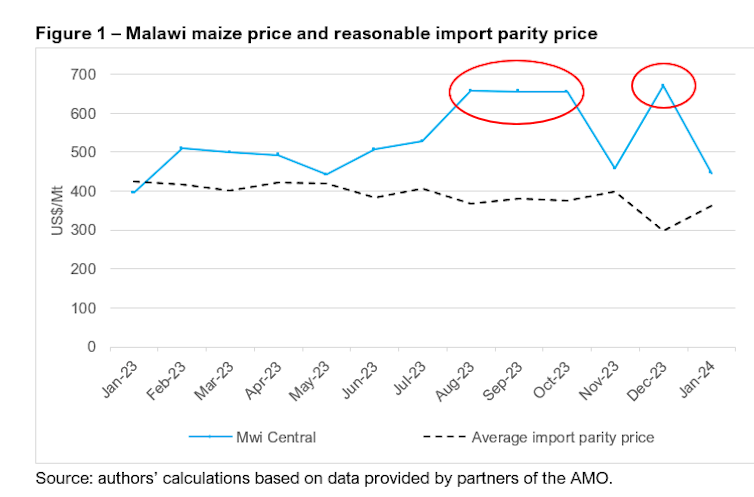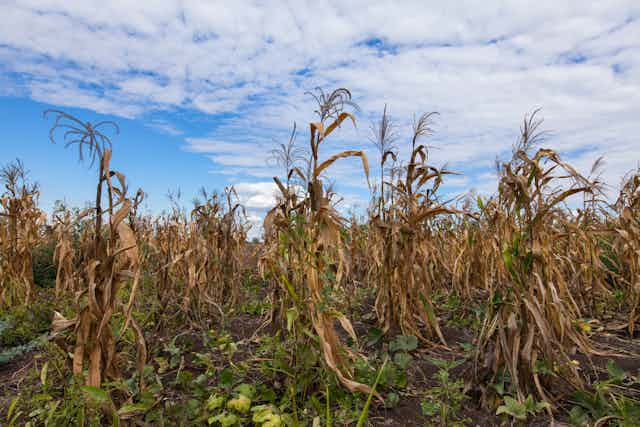Maize is the leading staple food in Malawi and crucial for food security. Typically, local production from smallholder farmers meets and exceeds annual requirements of around 3 million metric tonnes.
The country, however, is currently facing a crisis with 4.4 million Malawians (22% of the population) being food insecure.
This is due firstly to a poor harvest in 2023. The subsequent shortages led to a spike in prices which hit households hard. Such severe impacts on households could have been avoided, however, with more integrated regional markets to buffer against such shocks.
We analysed the dynamics behind these developments. We concluded that regional trade was not working well. Supply shocks driven by extreme weather were exacerbated by ad hoc trade bans and by apparent market speculation.
Read more: Enforcing competition would ease food price hikes in east and southern Africa
These factors added hundreds of millions of dollars to the total costs of maize for ordinary Malawians from August 2023 to January 2024. Our calculations indicate that households incurred additional spending of around US$200 million due to the elevated maize prices. Prices were elevated by 50%, in the period when most households in Malawi had to purchase maize as smallholders had exhausted their own production. Sharp price hikes have been seen in earlier years, such as in Kenya in late 2022, for similar reasons.
These numbers should be sounding a loud warning for expected supply volatility in future. Our view is that stakeholders, together with the national and regional competition authorities, should monitor markets and advocate for fair prices. They should intervene where appropriate if there are signs of anti-competitive conduct.
The dynamics
Trade from neighbours with good harvests could have mitigated the impact of supply shocks.
In 2023, facing high fertilizer prices, Malawi imported much smaller fertilizer volumes, including supplies for its Affordable Inputs Programme. The programme is a government initiative which seeks to promote food security and reduce poverty in Malawi by improving access to affordable farming inputs. The decision hurt crop yields. Maize harvests were also hit hard by Cyclone Freddy early in 2023.
The reduction in domestic maize supply would be expected to result in somewhat higher maize prices in Malawi. But Malawi’s neighbours in east Africa had abundant maize supply from the 2023 harvest. Prices in Malawi shouldn’t have increased above the costs of imports.
Read more: Zambia can meet growing food demand: how to fix what's standing in its way
Malawi prices shot up following the 2023 May harvest period (Figure 1). The prices of US$650 per metric tonne were far above those of neighbouring countries (such as $250 per tonne in south-west Tanzania). In addition, the prices hugely exceeded the import parity price based on adding transport and related costs for importing into Malawi.
From August to October, prices continued to be marked up substantially above the import parity price of around $370 per tonne. The import parity price represents a reasonable price and is calculated using the maize prices from Tanzania and Zambia, which averaged $300 per tonne over the period, and transport costs of US$50-80 per tonne.

In 2024 there are widespread concerns again about production in some southern African countries, such as Zambia, because of persisting dry weather conditions. At the same time, there is abundant production and good growing conditions in countries such as Tanzania, which remains a substantial maize net exporter, having experienced good harvests.
Trade and prices
The sharp reduction in prices in Malawi in November 2023 followed 40,000 tonnes of maize being imported by the Agricultural Development and Marketing Corporation from Mozambique to be distributed all over the country. Prices dropped to US$458 per tonne. However, the currency depreciation of almost 50% in the same month meant that prices in local currency did not fall.
The currency depreciation flowed through to huge local price increases in December as prices increased in US dollar terms to their highest levels: $670 per tonne. The December increases were due in large part to a ban initiated by Malawi on maize imports from Tanzania at the same time as Zambia was restricting maize trade to Malawi. The holders of maize stocks were able to earn staggering excess margins over the import parity prices that would have applied if trade had been possible.
In January 2024, maize prices declined to $446 as the trade restrictions with Tanzania were relaxed again. Market participants reported an influx of maize into the market from imports and traders with storage facilities. Even though prices declined in January, they were still inconsistent with fair market outcomes.
Harm to consumers
The highest prices from August to December coincided with the period when in a normal year most households in rural areas have exhausted their own produce and would have to buy additional maize.
On average each person in Malawi consumes about 9.5kg of maize per month. With an average overcharge on maize in the order of $200 per tonne, which is calculated as the difference between the prevailing price in Malawi and the import parity price, this means that an average household of 4.3 people spent an additional $8 per month to maintain their consumption. This assumes that the increases are passed through by millers. The cost shock also affects animal feed, affecting prices of foods such as poultry and eggs, which has not been considered in this analysis.
In conclusion, the sustained excess margins in Malawi indicate that regional trade is not working well. Supply shocks, such as those due to extreme weather, are exacerbated by ad hoc trade bans as well as by apparent market speculation, as conveyed to us by market participants.

